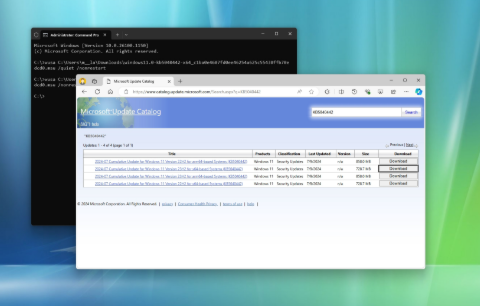
Keeping your Windows operating system up-to-date is crucial for system security, performance, and compatibility. While most users rely on automatic updates, there are times when you might need to install updates manually. Whether it’s because of network restrictions, update errors, or simply personal preference, this guide walks you through every step of manually installing Windows updates on Windows 10 and Windows 11.
Why Install Windows Updates Manually?
While Windows automatically downloads and installs updates, there are situations where manual installation is preferable or necessary:
-
You’re managing multiple PCs or a local network and want control over when updates are applied.
-
An automatic update fails, and you need to try a manual fix.
-
You need a specific update or patch not yet delivered automatically.
-
You’re using a metered or limited internet connection, and want to control bandwidth usage.
Prerequisites Before Installing Windows Updates Manually
Before jumping into manual updates, it’s important to prepare your system:
1. Check Your Current Version of Windows
Knowing your current Windows version helps determine which updates are needed.
-
Press
Win + R, typewinver, and press Enter. -
A window will show your Windows version and build number.
2. Ensure You Have Administrative Privileges
You need to be logged in as an administrator to install system updates manually.
3. Back Up Your Data
Even though updates are generally safe, unexpected issues can occur. It’s smart to back up your important files to an external drive or cloud storage before updating.
Method 1: Using Windows Settings to Install Specific Updates
Windows Settings allows you to manually check and install updates:
Step-by-Step:
-
Open Settings
-
Press
Win + Ito open Settings.
-
-
Go to Windows Update
-
For Windows 10: Click on Update & Security > Windows Update.
-
For Windows 11: Click on Windows Update in the sidebar.
-
-
Click “Check for updates”
-
This prompts Windows to scan for available updates.
-
-
Install Available Updates
-
If updates are found, click Download and install.
-
Restart your computer if prompted.
-
Pros:
-
Simple and doesn’t require additional tools.
-
Applies to most users for general update needs.
Cons:
-
You can’t install updates older than your current build.
-
Doesn’t work if your system has trouble connecting to update servers.
Method 2: Manually Download and Install Updates from Microsoft Update Catalog
The Microsoft Update Catalog is a centralized repository of all available Windows updates. It lets you download standalone installers (.msu files) for any update.
Step-by-Step:
-
Visit the Microsoft Update Catalog Website
-
Go to: https://www.catalog.update.microsoft.com
-
-
Search for the Update
-
Enter the KB (Knowledge Base) number of the update you want to install.
-
Example: Type
KB5034441and press Enter.
-
-
Find the Right Update for Your System
-
Look at the update description and select the one that matches your Windows version (e.g., Windows 10 x64-based systems).
-
-
Click Download
-
A pop-up appears with a link—click it to download the
.msufile.
-
-
Run the Update Installer
-
Double-click the downloaded
.msufile. -
Follow the on-screen instructions.
-
Restart your system when prompted.
-
Where to Find KB Numbers:
-
From official Microsoft documentation.
-
Via tech blogs or security advisories.
-
Through the Windows Update history on your PC.
Method 3: Using Windows PowerShell
Advanced users can use PowerShell to search for and install updates.
Step-by-Step:
-
Open PowerShell as Administrator
-
Type
PowerShellin the Start menu. -
Right-click and select Run as administrator.
-
-
Install the PSWindowsUpdate Module
-
Check for Updates
-
Install Updates
-
Restart if Required
Note: You might need to adjust execution policy by running:
Pros:
-
Ideal for bulk or automated installations.
-
Provides more control and detailed information.
Cons:
-
Not beginner-friendly.
-
Can be risky if used improperly.
Method 4: Using WSUS Offline Update Tool
WSUS Offline Update is a third-party tool that downloads and installs updates on systems without an internet connection.
Step-by-Step:
-
Download WSUS Offline Tool
-
Official website: https://download.wsusoffline.net/
-
-
Extract the Tool
-
Use a tool like WinRAR or 7-Zip to extract the archive.
-
-
Run UpdateGenerator.exe
-
Select your Windows version and architecture (e.g., Windows 10 x64).
-
Click Start to download the updates.
-
-
Run the Installer on Target System
-
Transfer the
clientfolder to the target computer. -
Run
UpdateInstaller.exeand follow prompts.
-
Pros:
-
Great for updating offline systems.
-
Useful in enterprise or air-gapped environments.
Cons:
-
Requires initial setup time.
-
Not officially supported by Microsoft.
How to Uninstall a Problematic Update
Sometimes, an update might cause system instability. You can manually uninstall it:
Step-by-Step:
-
Open Settings
-
Win + I> Update & Security > Windows Update > View update history.
-
-
Click “Uninstall Updates”
-
A Control Panel window will open with a list of installed updates.
-
-
Select the Update and Uninstall
-
Right-click the problematic update and choose Uninstall.
-
Common Issues and Troubleshooting Manual Windows Updates
1. Error Code During Installation
-
Search for the specific error code on Microsoft’s support site or forums.
2. Installer Doesn’t Start
-
Make sure the update is compatible with your Windows version.
-
Run Windows Update Troubleshooter:
-
Settings > System > Troubleshoot > Other troubleshooters > Windows Update.
-
3. Update is Already Installed
-
Windows will detect and prevent reinstallation of already-applied updates.
4. Incompatible Architecture
-
Ensure you’re installing the correct version (x86, x64, ARM).
Benefits of Manual Windows Updates
| Benefits | Description |
|---|---|
| Control | Choose what updates to install and when. |
| Selective Updating | Install only security patches or drivers you need. |
| Fix Failed Automatic Updates | Manually address update failures or errors. |
| Offline Capability | Update computers not connected to the internet. |
Best Practices for Manual Updating
-
Always check Microsoft’s documentation or tech blogs for update details.
-
Install updates in order: Servicing Stack Updates (SSU) before Cumulative Updates (CU).
-
Maintain a backup before major updates or upgrades.
-
Avoid third-party downloads—use Microsoft’s official catalog or tools.
Frequently Asked Questions (FAQ)
Q1: How do I find which updates I need?
-
Use
Settings > Windows Update > View update historyto see which updates are already installed. -
Refer to Microsoft Security Bulletins or Patch Tuesday summaries to know what’s released.
Q2: What’s the difference between Feature Updates and Cumulative Updates?
-
Feature Updates are major OS upgrades (e.g., 21H2 → 22H2).
-
Cumulative Updates are monthly patches that include security and bug fixes.
Q3: Is it safe to manually install updates from the Update Catalog?
-
Yes, if downloaded from https://www.catalog.update.microsoft.com, it’s official and secure.
Q4: Can I manually install updates on multiple PCs?
-
Yes. Download
.msufiles and copy them via USB to other systems, or use WSUS Offline Update.
Conclusion
Manually installing Windows updates is a powerful way to maintain control over your system’s security and functionality. Whether you’re dealing with failed automatic updates, managing devices on a network, or updating offline systems, this guide gives you the tools and knowledge you need.
Remember, regular updates are key to protecting your computer from vulnerabilities and improving overall performance. Even if you install updates manually, make sure you stay current with Microsoft’s release cycle.







